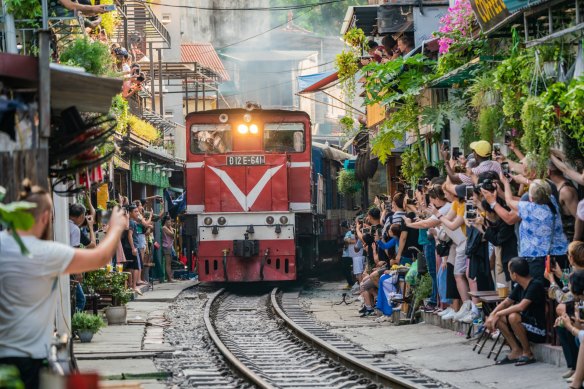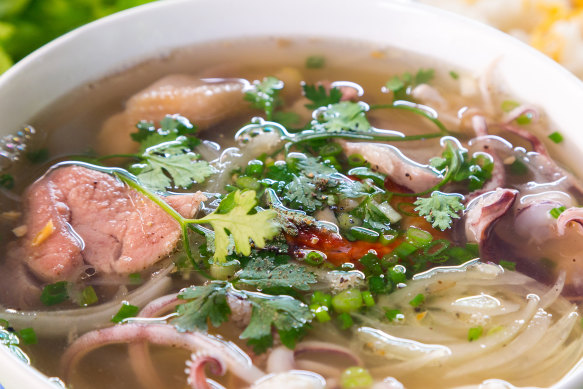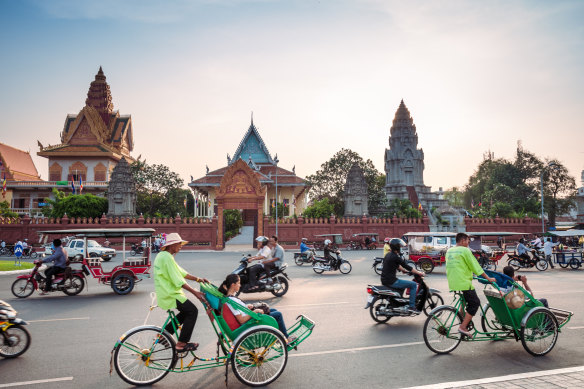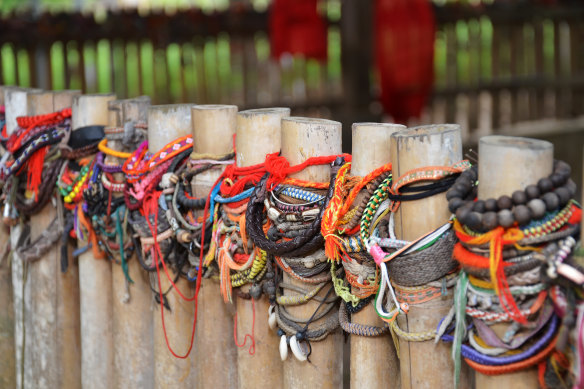Six must-do shore highlights of a Mekong River cruise
By Penny Watson
Sharing a border in mainland South-East Asia, Vietnam and Cambodia are bonded by the mighty Mekong River, and known equally for their unique cultures and heritage. From ancient temples and French-colonial architecture to war histories and exceptional cuisine, travellers wanting two passport stamps for the price of one holiday will do well to put them both on the itinerary.
Walk Hanoi’s Old Quarter

Hanoi Train Street, as it’s known to tourists, in the Old Quarter.Credit: Getty Images
The Old Quarter in Vietnam’s buzzy capital encapsulates the city’s rich history from its 15th century origins to the French colonial era. Located between Hoan Kiem Lake and Long Bien Bridge, a walk reveals shophouses selling Vietnamese coffee and colourful souvenirs, street stalls dishing out steaming bowls of bun cha (noodle soup with grilled pork), and pretty terrace houses with the paint peeling off their shuttered windows.
Compare the architecture of 9th century Bach Ma temple with the likes of St Joseph’s, a 19th century gothic-style cathedral, and don’t miss the city’s oldest retail hub, Dong Xuan Market, selling trinkets, clothes and confectionery.
Visit Ho Chi Minh City’s War Remnants Museum

War aircraft on display outside the War Remnants Museum.
Formerly known as the Museum of Chinese and American War Crimes, Ho Chi Minh City’s War Remnants Museum chronicles in deeply moving and engaging ways, the First Indochina War and the US invasion of Vietnam, known in Vietnam as the American War.
Intriguingly, its penetrating exhibits tell war stories from the victim’s perspective through photography, displays of war artefacts including the French guillotine, and installations of original US armoured vehicles and artillery. Together they are a window on significant periods of Vietnam’s history and an insight into understanding how the country ticks in modern times.
Savour Ho Chi Minh City’s cuisine

Fragrant pho bo noodle soup.Credit: Getty Images
Aussies have often savoured Vietnam’s salivatingly good cuisine before they’ve stepped foot in the country, but there’s nothing quite like crunching into a banh mi (baguette stuffed with pork, pate, carrot and coriander), or biting on a banh xeo (shrimp, pork and herb-filled pancake) in the culinary city of origin.
The footpaths of Saigon are busy with little stalls serving curbside food to patrons on plastic stools, and for guaranteed quality Ben Thanh Street Food Market and shops like Huynh Hoa and Pho24 make a tourist’s job easy. Expect clean, friendly service and authentic flavoursome local food for a quarter of the price of home.
Cyclo Phnom Penh’s city centre

Cyclo drivers remain a fixture of Phnom Penh.Credit: Getty Images
A great way to get a feel for Phnom Penh, the Cambodian capital, is on a cyclo tour. These three-wheeled modes of transport have low-slung front passenger carriages with the driver pedalling from behind. They came into being in the 1930s during the French colonial era and remain the most convenient and immersive means of getting around the city. What’s more, hiring one helps support Khmer cultural heritage and the livelihood of local drivers.
Most cyclo tour routes go through the French Quarter’s iconic Post Office Square with its gorgeous yellow-tinged mansions, and past architectural wonders including the Silver Pagoda and incredible Art Deco Phsar Thmei central market.
Visit Phnom Penh’s Killing Fields

Coloured bracelets dedicated to Killing Field victims.Credit: Getty Images
During the Khmer Rouge reign of terror, between1975 and 1979, an estimated 17,000 Cambodians were executed at Choeung Ek on the outskirts of Phnom Penh. Known as The Killing Fields, this is the best known of an estimated 300 execution sites with mass graves found throughout Cambodia.
The memorial to the atrocities carried out here on communist dictator Pol Pot’s orders is made even more poignant by the setting. This open-air museum is a serene place, a former orchard with blossoming fruit trees, grass and wild garden beds which are alive with white butterflies. The tranquillity adds weight to the notion that this is less a tourist attraction, more a place to contemplate humanity and our understanding of the complex world we inhabit.
Marvel at Siem Reap’s Angkor Wat

Aerial views of the Angkor Wat ruins.Credit: Getty Images
Visiting Cambodia and not seeing Angkor Wat would be akin to going to Paris and not laying eyes on the Eiffel Tower. The 12th century Hindu-Buddhist complex of temples, terraces and canals is enveloped by more than 400 square kilometres of root-tangled jungle on the outskirts of Siem Reap.
It is UNESCO World Heritage-listed due to its religious and archaeological significance with intact bas-reliefs and decorative stupas and pillars that tell stories of ancient Khmer lives.
Sign up for the Traveller Deals newsletter
Get exclusive travel deals delivered straight to your inbox. Sign up now.